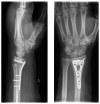Outcome Analysis of Distal Radius Fracture with Orthosis Versus Cast Immobilization after Palmar Plate Osteosynthesis: A Randomized Controlled Study
- PMID: 36675791
- PMCID: PMC9864856
- DOI: 10.3390/jpm13010130
Outcome Analysis of Distal Radius Fracture with Orthosis Versus Cast Immobilization after Palmar Plate Osteosynthesis: A Randomized Controlled Study
Abstract
Although the benefits of hand orthoses were shown in previous studies, they have not been able to establish themselves in clinical routines. With a focus on patient satisfaction, this study aimed to evaluate the latest generation of hand orthoses after palmar plate osteosynthesis for isolated distal radius fractures in comparison with circular plaster casts. 50 patients (16% dropout rate) were randomly assigned to an orthotic group (immobilization by orthosis, OG) or a control group (immobilization by a plaster cast, CG). Intra-articular fractures were present in 74% of the cases, and unstable AO C3 fractures in 26%. Questionnaires on patient satisfaction, documentation of the time required, clinical scores (DASH, SF-36), range of motion, grip measurements and radiographs were used for evaluation. The OG proved to be equivalent to the plaster treatment in terms of patient satisfaction, and stability of the reduction, as well as clinical scores DASH and SF-36. The OG was even superior in terms of personal hygiene (p = 0.011), handling (p = 0.008) and better adaptability (p = 0.013). Significantly less time was required to apply the orthosis (p < 0.001). In addition to the good results achieved so far, the study showed that the latest generation of orthoses has several advantages over plaster cast therapy, and could therefore become established in everyday clinical practice.
Keywords: Disabilities of Arm, Shoulder and Hand (DASH-Score); circular plaster cast; distal radius fracture; hand immobilization; orthosis; palmar plate osteosynthesis; patient satisfaction.
Conflict of interest statement
The funders had no role in study design, data collection and analysis, interpretation of the data, decision to publish, or preparation of the manuscript. There are no financial or non-financial competing interests. This includes: employment, consultancy, patents, products in development, marketed products, etc. The authors declare no further conflict of interests.
Figures







References
-
- De Putter C.E., Selles R.W., Polinder S., Hartholt K.A., Looman C.W., Panneman M.J.M., Verhaar J.A.N., Hovius S.E.R., van Beeck E.F. Epidemiology and Health-Care Utilisation of Wrist Fractures in Older Adults in The Netherlands, 1997–2009. Injury. 2013;44:421–426. doi: 10.1016/j.injury.2012.10.025. - DOI - PubMed
Grants and funding
LinkOut - more resources
Full Text Sources
Miscellaneous

